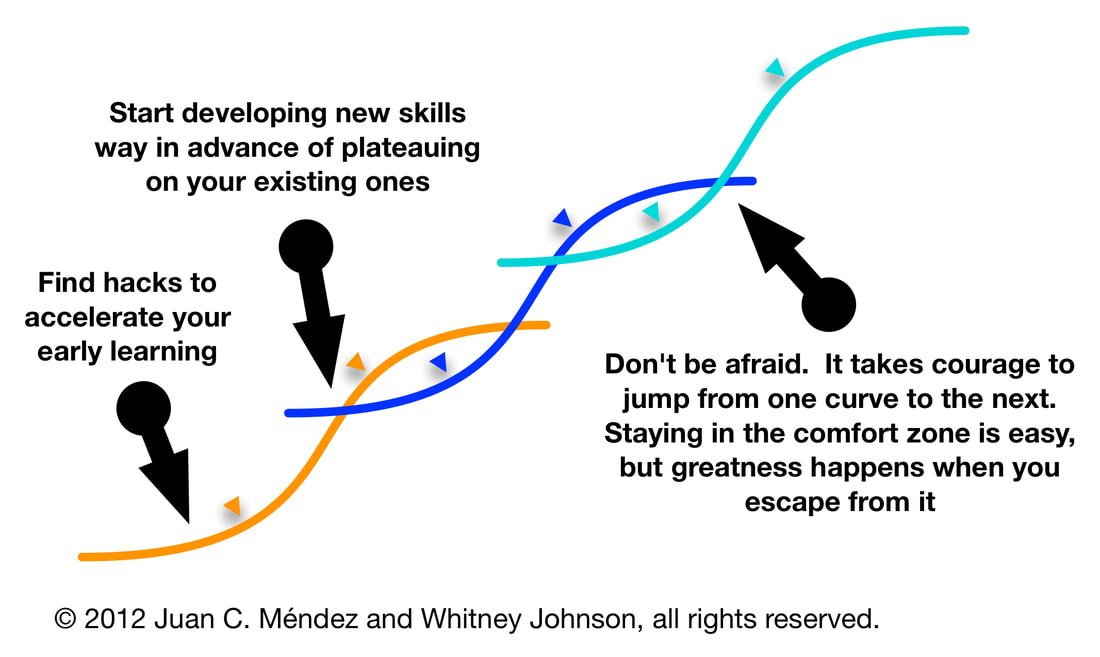|
I recently spoke to a gathering of lawyers about navigating career crossroads at midlife. This topic arises frequently with my clients: high-achieving professionals who are experiencing malaise, frustration or disengagement in their work. Many of them assume that finding a new job is their only solution, but they often resist relinquishing the aspects of their jobs that are working for them. Could there be a solution that involved repairing their jobs instead of replacing them? My “a-ha” moment came when reading an article by Whitney Johnson in the Harvard Business Review. According to Johnson, career growth can be visualized as an s-shaped curve. We enter the curve at the bottom of the “s”; when we start something new, we invest our time and effort to build proficiency, often without much to show for it. “But through deliberate practice, we gain traction, entering into a virtuous cycle that propels us [up] into a sweet spot of accelerating competence and confidence. Then, as we approach mastery, the vicious cycle commences: the more habitual what we are doing becomes, the less we enjoy the ‘feel good’ effects of learning: these two cycles constitute the S-curve.” In other words, we are most engaged and successful in our work when we are tackling new challenges and harvesting the fruits of our labor, and most disengaged once we’ve hit the mastery phase. According to Johnson, “As we approach mastery, our learning rate decelerates, and while the ability to do something automatically implies competence, it also means our brains are now producing less of the feel-good neurotransmitters — the thrill ride is over.” To avoid that sense of burnout or malaise, Johnson recommends creating a series of interlocking s-curves; before you hit the mastery phase of your current curve, you can transition to the next new challenge. The best time to design your next s-curve is before you reach your next plateau. Instead of looking for a new job whenever you hit the mastery phase (which can be a time-intensive and disruptive proposition) consider looking for other opportunities to engage in something new.
What are you curious about? What are some skill areas in which you’d like to stretch and grow? Consider identifying a new development opportunity within your current job or in a professional or community organization. Perhaps there’s a new specialty you’d like to develop, a committee you’d like to chair, a conference you’d like to attend, a presentation you’d like to deliver, or a volunteer initiative you’d like to champion. Identify your next challenge and commit to bringing it to fruition. It’s possible you may conclude that for you to truly flourish, your next s-curve will point to a new job, but you may be just as likely to conclude that immersing yourself in a new challenge gives you the lift you were looking for. Whether you decide to stay or go, it’s never too late to try something new. In fact, engaging your inner learner may hold the key to your renewed professional vitality.
0 Comments
 Photo by Markus Spiske on Unsplash Photo by Markus Spiske on Unsplash Earlier this year, I took a gardening class to learn how to start a vegetable garden. One piece of advice stuck with me: it’s better to water deeply and less frequently than to water often but in a shallow manner. Growth happens below ground. We need to nurture the roots, not just the surface. Of course, the same wisdom applies to our own growth. If we only tend the surface and mine the weeds, it’s hard for lasting change to take root. We know this, but most of us are too busy to summon the time and resources to do the deep work when we are busy trying to survive. If this is where you find yourself right now, that’s ok. Perhaps the best you can do right now is to water a little bit every day to get you through to a calmer moment. But if you find that your summer is more spacious, consider a goal or new direction you would like to nurture in the coming months. What would it take to nourish the roots of this new idea, and what will you commit to doing? Can you carve out the time and resources to water deeply? I hope that an abundant harvest lies in store for you!  Originally published at: http://www.abalcc.org/2017/12/05/5-things-successful-job-seekers-long-ever-start-job-search/ Looking for a job is stressful. Most attorneys crave stability and predictability, so when we start fantasizing about greener pastures, it’s fair to say that our relationship to our current job is less than optimal. By the time we’ve reached this point, we are typically stressed, questioning our professional value, and feeling isolated from colleagues. Needless to say, these factors don’t exactly add up to a position of strength when you enter the job market. If we wait too long, and the current situation becomes dire, our focus becomes centered on escaping from a toxic job, rather than moving toward an opportunity. We operate in a framework of scarcity, especially if we haven’t done much to create a pipeline of opportunities. We end up grabbing the first lifeboat that comes along out of fear that there will not be others behind it. And under these conditions, scrutinizing potential employers feels like a luxury we can’t afford. Not surprisingly, we may find that we’ve traded in one set of problems for another. If the goal is to approach the job search from a position of clarity, confidence, and control, then we must start the process earlier. Indeed, some of my most successful clients have sown the seeds for their next transition long before they ever contemplated leaving their jobs. These successful job seekers figured out what they wanted, and developed clarity about their strengths. They became effective at demonstrating their abilities, often attracting the attention of prospective employers. And when these attorneys decided to seek out a new role, they had a robust network to tap into. With some intentional career management, you can create these same fertile conditions to generate new opportunities for yourself, either within your current organization or elsewhere. As you advance through your career, the best opportunities will be the ones that grow organically from your efforts, not ones found through a panicked search of online job boards. When I think of the attorneys I know who have done this well, a few patterns emerge. Here are some of their best practices for you to consider. 1. Blossom where you are planted. The best way to make yourself attractive to future employers is to become a valued contributor to your current organization. By providing excellent service to internal and external clients and developing mastery over your work, you will develop a reputation as an excellent lawyer while building the skills sought by future employers. Make it a priority to build strong relationships internally with peers and colleagues with more seniority who can help shape your skill development and ultimately serve as a reference down the road. It’s also common sense: you’re not likely to produce your best work when you’ve already got one foot out the door. Instead, make yourself the kind of attorney that others will seek to add to their team. 2. Keep track of your accomplishments. We work in an evidence-based profession. Future employers will want to see what results you’ve obtained, what problems you’ve solved, and what challenges you’ve undertaken. Waiting until an interview to conjure up specific examples of past behavior on the fly is not a good approach. Develop a practice of documenting your accomplishments. Keep a journal or computer file where you can record achievements, victories, and recognition you’ve earned. Save the email messages you receive from appreciative supervisors and clients. Keep your online bio and LinkedIn profile (and your resume, for that matter) up-to-date with any articles you write, presentations you give, and leadership positions you hold. In the short run, you can use this information in your performance evaluation process; in the long run, having a cache of anecdotes to demonstrate how you’ve mastered a variety of situations will be priceless on your next job interview. 3. Look toward the horizon; what will it take to get there? Although your feet may be planted firmly in your current role, lift your eyes toward the horizon. Do you have a sense of what you’d like to be doing in the next year? Next 5 years? For inspiration, look at the attorneys you admire who are a bit farther down the path. What expertise and experience would it take to step into that work? Next, assess if there are gaps between your current experience and what you expect future employers will seek, and start filling them now. Solicit new responsibilities at your current job to develop those skills. If your opportunities for growth are limited at work, seek out pro bono experience, read articles and attend CLE programs to continue refining your portfolio. Don’t limit yourself to being an information consumer. Publish articles, cultivate a presence on social media and speak at CLEs. Become known for your expertise and demonstrate leadership on the issues that matter most to you. 4. Network now! The goal of networking isn’t to build a collection of business cards or LinkedIn connections. Instead, focus on developing authentic relationships with colleagues who can share insights about their work, introduce you to people and opportunities, and serve as a sounding board. To be most effective, you want to cultivate your relationships steadily over time, not just cram them in to the few weeks leading up to a job interview. Find ways to stay connected to the folks in your network. Send holiday greetings in December. Comment on their LinkedIn updates. Offer congratulations when they’ve had an accomplishment. Share resources and opportunities when you are in a position to do so. From time-to-time, reach out to someone new whose work interests you. Invite them to meet in person to learn more about what they do and the path they took to their work. If you are curious about pursuing something similar, ask them to assess your credentials and offer tips on how to fill any gaps in your experience. Use the same strategies described above to stay in touch with these new colleagues. Creating a steady, credible presence with your colleagues will keep you top-of-mind for opportunities. You will also be in a much stronger position to solicit “intel” and guidance when interviewing with an organization your colleagues are connected to. 5. Know what you want. By utilizing the strategies I’ve been describing, you may find that opportunities come to you before you ever embark on a formal search. While this can be exciting, it can also be destabilizing by undermining a sense of control over the search. You don’t want the excitement of being courted for a job to blind you to its red flags. For this reason, it’s important to be clear about what you need from your next job. Have a sense of the direction you’d like your career to take and only entertain positions that will advance you toward your goals. Develop an awareness of the work setting in which you perform at your best, and make sure any new opportunity supports those conditions. Understand your financial needs and any obligations impacting your time and commute that you should take into consideration. By being clear about what will make a job a good opportunity for you, you will have the confidence to walk away from offers that will not position you for success. And by engaging in this process long before you feel the need to leave, you do not need to desperately cling to jobs that are a bad fit. The beauty of focusing on your professional development is that you become a better lawyer long before you ever pursue a new job. By cultivating a strong reputation and demonstrating your excellence, you are more likely to be sought out for opportunities either inside or outside of your current organization. And if you end up applying for jobs the traditional way, you’ll find that you’ve developed the expertise, insight, and professional relationships to showcase your value to your future employer. When we told people we were moving from California to Oregon, all anyone wanted to talk about was The Rain. Were we prepared for all the rain? Did we understand that there would be cold, wet winters (at least by Bay Area standards)? Were we SURE we were prepared for this?
But nobody told me about the rainbows, and how they are an almost commonplace occurrence here. In fact, I now recognize “rainbow weather” and routinely scan the sky to see if it will offer a display. Sometimes the rainbows are barely detectable; other times they are so breathtaking that I’ve had to pull my car over to the side of the road to enjoy a better view. Last night, a downpour shook the remaining leaves from our trees and pounded the roof with rain. This morning, we were rewarded with a Technicolor display. During this Thanksgiving week, I am grateful for this reminder that storms eventually pass, and that we sometimes get lucky enough to catch some magic. I wish all of you a joyful week filled with safe travels, good companionship, and delicious meals. Happy Thanksgiving! |
AuthorI'm a certified coach and former lawyer based in Portland, OR. I love helping lawyers and other professionals engage more fully in their professional lives. Archives
November 2018
Categories |




 RSS Feed
RSS Feed